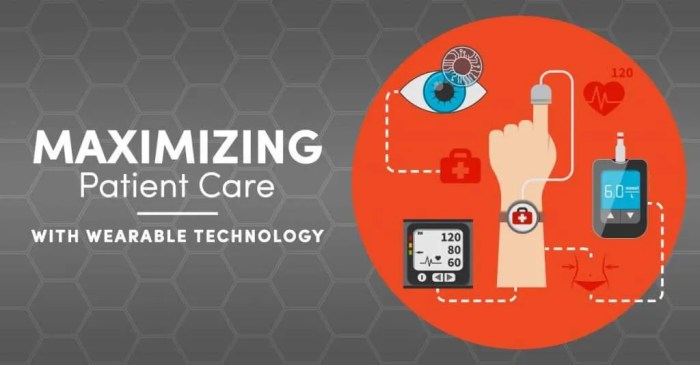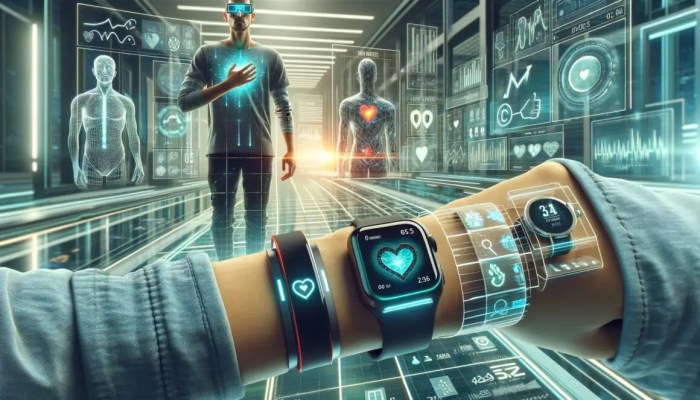Kicking off with How Wearable Tech Is Revolutionizing Healthcare Delivery, this opening paragraph is designed to captivate and engage the readers, setting the tone casual formal language style that unfolds with each word.
Wearable technology in healthcare is changing the landscape of patient care and healthcare delivery. From monitoring health to enhancing patient care, wearable devices are revolutionizing how healthcare is approached. This article delves into the impact, benefits, and challenges of integrating wearable tech into healthcare systems.
Wearable Tech Overview

Wearable technology in healthcare refers to devices that are worn by individuals to monitor various health metrics and provide valuable data for healthcare professionals. These devices are designed to be comfortable, easy to wear, and seamlessly integrate into daily life.
Examples of Popular Wearable Devices
- Fitbit: Tracks activity levels, heart rate, and sleep patterns.
- Apple Watch: Monitors heart rate, ECG, and workout metrics.
- Oura Ring: Measures sleep quality, heart rate variability, and activity levels.
Benefits of Wearable Technology in Monitoring Health
Wearable devices enable continuous monitoring of health parameters, providing real-time data that can help in early detection of potential health issues. This proactive approach allows for timely intervention and personalized healthcare plans. Additionally, wearable tech promotes patient engagement and empowers individuals to take control of their health.
Differences from Traditional Healthcare Delivery
Wearable technology shifts the focus from episodic care to continuous monitoring, allowing for a more holistic view of an individual's health. Traditional healthcare methods often rely on sporadic visits to healthcare providers, whereas wearable devices provide constant feedback and data, leading to more personalized and proactive healthcare delivery.
Impact on Patient Care
Wearable technology is transforming the way patients engage with their healthcare providers, offering a more proactive approach to managing their health and well-being. These devices provide real-time data and insights that enable patients to take control of their health in a more personalized and informed manner.
Remote Patient Monitoring
Wearable devices play a crucial role in remote patient monitoring, allowing healthcare providers to track vital signs, medication adherence, and other health metrics from a distance. For example, patients with chronic conditions like diabetes or heart disease can use wearable devices to continuously monitor their blood glucose levels or heart rate, sending this data directly to their healthcare team for timely intervention if needed.
- Remote monitoring helps in early detection of health issues and prevents unnecessary hospital visits.
- It enables healthcare providers to offer personalized care plans based on real-time data.
- Patients feel more empowered and engaged in their own healthcare management.
Preventive Healthcare
Wearable technology also plays a significant role in preventive healthcare by promoting a proactive approach to health and wellness. These devices can track physical activity, sleep patterns, and even stress levels, providing users with valuable insights into their overall health and lifestyle habits.
- By encouraging regular exercise and healthy habits, wearable devices help prevent chronic diseases.
- They remind users to stay hydrated, take breaks, or practice mindfulness, promoting overall well-being.
- Healthcare providers can use this data to offer personalized preventive care recommendations.
Healthcare Delivery Enhancement
Wearable technology has significantly enhanced the efficiency of healthcare delivery by providing real-time data and personalized insights to healthcare providers. This has revolutionized the way patients are monitored and treated, leading to improved outcomes and reduced healthcare costs.
Improved Monitoring and Communication
- Wearable devices allow healthcare professionals to remotely monitor patients' vital signs, medication adherence, and activity levels, enabling early detection of any health issues.
- Real-time communication through wearable tech ensures prompt intervention in case of emergencies, reducing response times and improving patient outcomes.
- Healthcare providers can access patients' data anytime, anywhere, leading to more proactive and personalized care delivery.
Early Disease Detection
- Wearable devices equipped with sensors can detect subtle changes in the body, facilitating early detection of diseases such as heart conditions, diabetes, and respiratory issues.
- Continuous monitoring through wearables enables healthcare professionals to identify patterns and trends in patients' health, allowing for timely interventions and preventive measures.
- Early disease detection not only improves patient outcomes but also reduces the burden on healthcare systems by preventing the progression of diseases to advanced stages.
Challenges and Limitations
- Interoperability issues between different wearable devices and healthcare systems pose a challenge in integrating wearable technology seamlessly into existing healthcare workflows.
- Data security and privacy concerns related to the collection and sharing of sensitive health information through wearables need to be addressed to ensure patient confidentiality and trust.
- Cost implications for implementing wearable technology across healthcare facilities, training healthcare staff, and ensuring regulatory compliance are significant barriers that need to be overcome.
Data Collection and Analysis

Wearable devices play a crucial role in collecting and analyzing health data, providing valuable insights for both patients and healthcare providers.
Data Collection Process
Wearable devices utilize various sensors to continuously monitor vital signs, physical activity, sleep patterns, and other health-related data. These devices track metrics such as heart rate, blood pressure, steps taken, calories burned, and even stress levels in real-time.
- The sensors in wearable devices collect raw data from the user's body, which is then processed by the device's internal algorithms.
- Collected data is stored either on the device itself or transmitted wirelessly to a paired smartphone or computer for further analysis.
- Advanced wearables can also sync data to cloud-based platforms for easy access by healthcare providers and researchers.
Importance of Data Accuracy and Security
Ensuring the accuracy and security of health data collected by wearable devices is paramount to maintaining trust between users and healthcare providers.
- Accurate data is essential for making informed decisions about patient care, treatment plans, and overall health management.
- Data security measures, such as encryption and secure data storage, help protect sensitive health information from unauthorized access or breaches.
- Compliance with regulations like HIPAA (Health Insurance Portability and Accountability Act) is crucial to safeguarding patient privacy and maintaining data integrity.
Utilization of Data in Personalizing Patient Care
Healthcare providers leverage the data collected by wearable devices to personalize patient care, improve treatment outcomes, and enhance overall healthcare delivery.
- By analyzing trends and patterns in a patient's health data, providers can identify potential health risks or issues early on and intervene proactively.
- Personalized treatment plans can be tailored based on individual health metrics, preferences, and lifestyle factors, leading to more effective and patient-centric care.
- Remote monitoring of patients through wearable technology allows for real-time adjustments to treatment plans, reducing the need for frequent in-person visits and improving patient convenience.
Final Conclusion

In conclusion, the integration of wearable technology in healthcare delivery is paving the way for a more personalized and efficient approach to patient care. With the ability to collect and analyze data in real-time, wearable devices are reshaping the future of healthcare.
As technology continues to advance, the possibilities for wearable tech in healthcare are endless, offering a glimpse into a more connected and proactive healthcare ecosystem.
Questions Often Asked
How can wearable tech benefit healthcare delivery?
Wearable tech can improve monitoring, enhance patient care, and help in early disease detection.
What are some popular wearable devices used in healthcare?
Popular examples include fitness trackers, smartwatches, and medical alert systems.
How do wearable devices collect and process health data?
Wearable devices use sensors to collect data and transmit it to a connected device for processing.
What are the challenges of integrating wearable tech into healthcare systems?
Challenges include data security, interoperability with existing systems, and ensuring accuracy of data collected.



